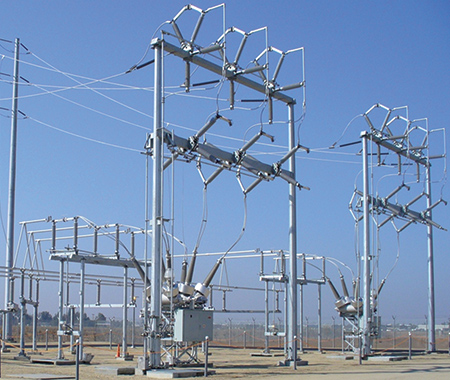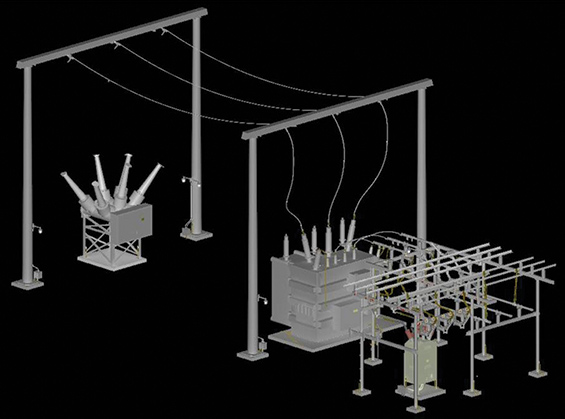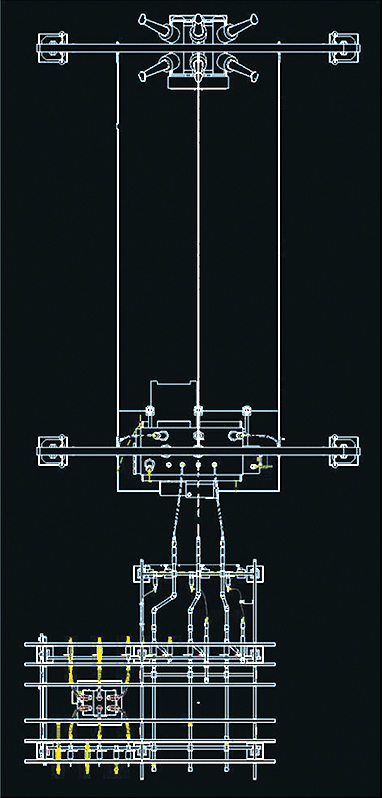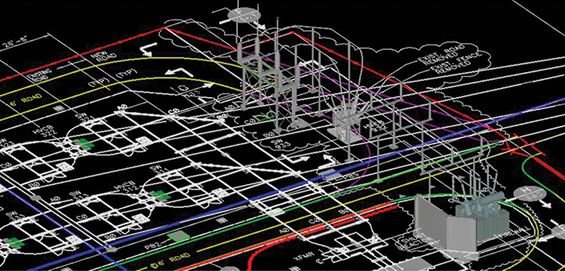The Smart Grid Tsunami
Like so many utilities with aging infrastructure, Pacific Gas and Electric Company (PG&E) needed to modernize its substations and boost service reliability. “As we began a massive, multi-year smart-grid project to address these issues, we knew it would be difficult for our substation design team to keep up with the volume of design projects using our traditional, manual design process,” explained Alexander Liang, senior design engineer at PG&E. “With over 1,000 substations in our electric system, we needed to work faster and smarter – so we turned to Bentley Systems for help.” A long-term Bentley customer and one of the United States’ largest electric and gas utilities, PG&E is based in San Francisco, California, and has over 22,000 employees. The company provides natural gas and electric service to approximately 15 million people throughout a 70,000-square-mile service area in northern and central California.

Reaching the Limitations of Early CAD Technology
PG&E’s substation design practice had remained fundamentally unchanged since the 1980s when the company adopted computer-aided drafting (CAD). While CAD initially increased productivity, inefficiencies remained because of the two-dimensional, graphics-only nature of early CAD technology. Consisting of only vector lines, shapes, dots and text, CAD drawings lack any intelligence about the physical entities they represent. For PG&E, this meant that for each substation project, designers had to manually create, maintain, and update designs across countless 2D drawings. “We would draft each and every view pertaining to an outdoor arrangement of equipment,” explained Liang. “We’d start by drawing up the plan view and then proceed to draw elevations and sections, each time relying on our experience to figure out what each view should look like.” In an effort to save time, designers often copied drawings from other projects, but if these seed drawings were incompletely or incorrectly adapted, the new project was fraught with errors. Furthermore, whenever a design change was made, it had to be manually propagated across all impacted drawings. “This was one of the main drawbacks of unintelligent CAD design – the excessive time people spent manually drafting and updating various views of the same equipment,” continued Liang.

Fig. 2: An intelligent 3D model integrates 3D Physical and 2D electrical design
Inefficiencies were not limited to the drafting process. To create a bill of material for a given project, designers had to visually inspect physical arrangement drawings, count equipment and measure conductor and conduit lengths. The information was then entered into a separate system for procurement. “This manual process was time consuming, inconsistent, and prone to error,” said Liang.
Leaping Ahead to Intelligent Substation Design
Given these limitations, management determined that its existing substation design process would make it difficult – if not impossible – to meet the demands of the smart-grid project. “We needed design technology that could help us accelerate substation design projects while significantly improving quality and accuracy – and reduce the overall cost of our substation engineering design and construction,” explained Amir Mohebbi, manager of substation engineering at PG&E. They looked for a solution and ultimately chose the only integrated software product for intelligent electrical and physical substation design.
PG&E worked with Bentley to review their existing design process and define requirements. “Our analysis revealed that the software could indeed help us improve productivity and quality while preserving important design processes,” said Mohebbi. “Equally important, we could deploy it cost effectively.” Bentley consultants began the process of configuring the technology to meet PG&E’s specific needs.
They defined new design workflows and built a library of intelligent symbols, devices, and 3D models that designers could pull from and incorporate into designs. Onsite training of designers was vital to ensuring a smooth transition from 2D to 3D site design. And in about six months, Bentley Substation was put into production as the primary design tool used for all projects.

Fig.3: Accurate 2D construction views are
now created automatically from the 3D model
Transforming the Design Process
PG&E designers were able to switch their focus from drafting a set of drawings to constructing an intelligent 3D substation model. Because the software has a database running behind the CAD engine, designers can pull from a growing library of digital ‘parts’ stored in the database and place them into an arrangement – a 3D model that encapsulates all possible views of the substation design. Everything that gets placed into a design has information relating to that particular piece of equipment.
Producing accurate 2D construction views is a quick and hassle-free process. According to Nam Trinh, senior design engineer at PG&E, who together with Liang helped transition the company to the new system, “Now, the designer only needs to assemble equipment once in the 3D design and then take snapshots of necessary views.” Any changes designers make to the 3D model after the views are taken are automatically reflected across all views. So if a designer edits the properties on one drawing page, for instance, all other drawings containing this equipment are updated instantly, since they are all linked.
40 Percent Faster Design Time
Results from the first five projects developed using Bentley Substation showed a 40 percent reduction in physical and electrical design time. With the average project requiring 52 drawings and each drawing previously requiring approximately 24 hours of manual drafting, the projected savings add up to over 500 hours per project. PG&E estimates this will result in USD 4.7 million in annual savings when averaged across 120 substation projects completed annually.

Fig.4: For brownfield design, legacy vector and raster drawings are combined with 3D equipment models
Fewer Errors and Higher Quality Drawings
PG&E experienced a dramatic reduction in the total number of errors in substation designs. Physical layout drawings are more accurate because they are derived from the intelligent 3D substation model, and schematic drawings have fewer errors thanks to the use of intelligent symbols. “Since relays and other electronics are predefined in symbology and device families, duplicate contacts are prevented, and the correct stud numbers are used,” said Trinh. Additionally, automated numbering prevents the same wire tag from appearing on different wires.
Another benefit of Bentley Substation has been an overall improvement in drawing aesthetics and quality. Previously, these attributes could vary significantly depending on the designer and level of experience. A new level of consistent quality has been achieved by dramatically reducing manual drafting and enforcing PG&E design standards. PG&E estimates that the increases in engineering drawing accuracy, quality and efficiency enabled by Bentley Substation deliver average construction savings of 40 labor hours per substation project, or USD 1 million in additional annual savings across all substation projects.
Faster and More Accurate Bills of Material
PG&E also saves time by automatically generating bills of material for each project. “Each component placed into a substation design has a part number associated with it,” explained Trinh. “Bentley Substation keeps track of where and how many of each part has been placed so we can quickly run a report on equipment, sorted by part number, for an accurate bill of material.”
Positioned to Deliver the Smart Grid
Bentley Substation is in full production mode at PG&E. Over 85 engineers and drafters have been trained, and the software supports all greenfield and brownfield projects. “Bentley Substation V8i and their professional services have exceeded our expectations in terms of delivering outstanding value,” said Trinh. “Bentley’s ongoing development and support has helped Pacific Gas and Electric Company meet its goals and provide twice the amount of engineering services with our current staff.” PG&E is now deploying ProjectWise, Bentley’s engineering content management and project collaboration software, to improve management of the project files created in Bentley Substation. Increased productivity, enhanced design quality, and lower costs are expected benefits of ProjectWise. PG&E is well positioned to sustain and grow its network of substations and realize its smart-grid vision: provide customers safe, reliable, secure, cost-effective, sustainable, and flexible energy services.
About the Author
 Victor Alvarez is a product management and product marketing professional with over 18 years of experience in high-technology environments. He is Senior Manager, Applications Advantage at Bentley Systems where his responsibilities include the company’s utilities, communications, electrical, and mining product lines. Victor holds an MS in Systems Architecture and Engineering from the University of Southern California and an MBA from the UCLA Anderson School of Management.
Victor Alvarez is a product management and product marketing professional with over 18 years of experience in high-technology environments. He is Senior Manager, Applications Advantage at Bentley Systems where his responsibilities include the company’s utilities, communications, electrical, and mining product lines. Victor holds an MS in Systems Architecture and Engineering from the University of Southern California and an MBA from the UCLA Anderson School of Management.







